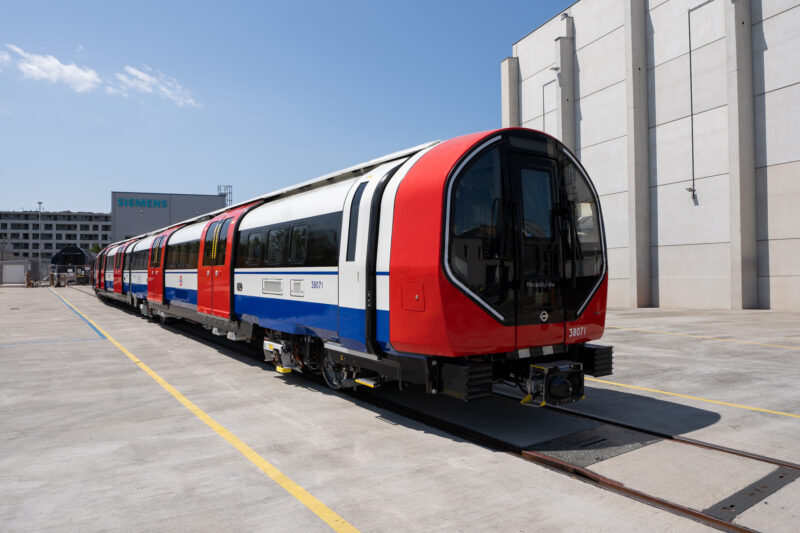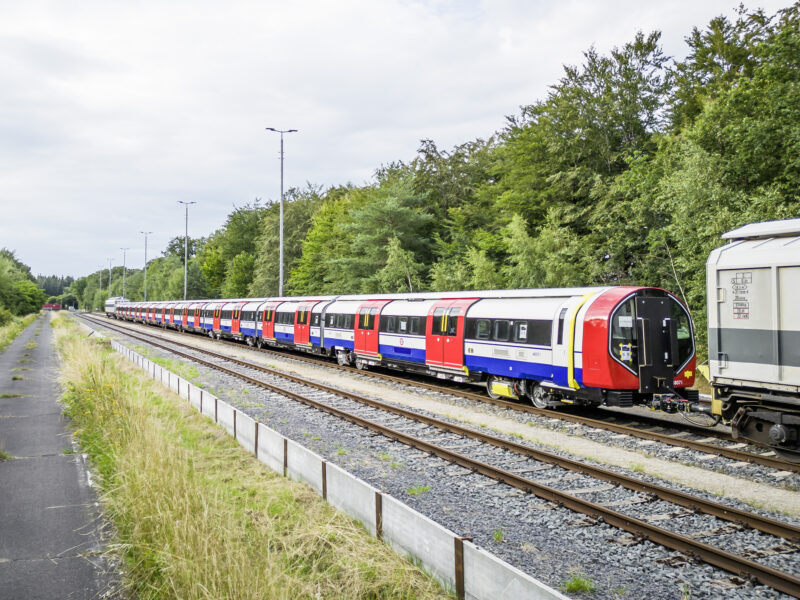The first of the new trains for Transport for London has made it off the production line and is off to Germany for testing.

This train – the first of 94 – will be used to replace the existing trains used on the Piccadilly Line under the New Tube for London programme. With it complete, it has been sent to the Siemens Test and Validation Centre in Wegberg-Wildenrath, Germany.

The first nine-carriage train came off the production line in Vienna at the end of July before being transported to the Test and Validation Centre, with some eagle-eyed people spotting it en route to Germany. Meanwhile, work to complete Siemens Mobility’s new site in the East Riding of Yorkshire, where around half the trains will be assembled, is near completion.
The new train will be put through tests including acceleration and braking functionality, noise and vibration trials, as well as testing all the equipment onboard – both hardware and software – and functional tests of the interfaces the train will have with off-train equipment, with the trains currently due to enter squadron service in 2025.
The New Tube for London programme covers some of the Deep-Level tube lines (Piccadilly, Bakerloo, Central and Waterloo & City Lines), subject to ongoing funding. The current programme will allow the replacement of the Piccadilly Line trains, however, the rest of the programme is in the air.
Sambit Banerjee, Managing Director for Rolling Stock and Customer Services for Siemens Mobility UKI, said:
“The first new Piccadilly line train is now at our world class testing facility in Germany where it will undergo a period of extensive testing. This is the first stage of testing before London Underground’s newest train reaches the UK for further testing and integration in late 2024. I am incredibly proud to see this first train continue its journey towards enhancing passenger experience and transforming rail travel on the Piccadilly line.“
The Mayor of London, Sadiq Khan, said:
“Ensuring London’s transport network keeps up with the demands of our great city means continually improving and updating our infrastructure.
“These new trains will transform travel on the Piccadilly line, making them more comfortable for passengers and improving people’s daily journeys. Improvements like this also have a vital role to play in making our network more energy efficient and can only happen with continued government investment. I will continue to work with TfL and the Government to ensure we get the long-term investment our network needs and help build a better, more prosperous city for all Londoners.”
Stuart Harvey, TfL’s Chief Capital Officer, said:
“Seeing the first of our new Piccadilly line trains getting ready to undergo rigorous testing clearly demonstrates the hard work that has been going on behind the scenes to build a new fleet of state-of-the-art Tube trains for London. We remain on track for these new Piccadilly line trains, which will see air-conditioning brought to the Deep Tube network for the very first time, to start serving our customers from 2025.
“We hope to follow the introduction of these new trains to the Piccadilly line by doing the same on the Bakerloo line, replacing the 51-year-old trains that it currently operates, and then by introducing new signalling across the Deep Tube lines to realise the full benefits of the new trains. However, such large-scale investment will not be possible without continued capital investment from the Government from April 2024. We will continue to work with the Government to make the case for long term investment in London to make it an even better, greener, safer and more successful place for everyone.”
The trains themselves
The Piccadilly line trains are based on Siemens Mobility’s Inspiro family of metro trains and offer passengers an improved customer experience with walk-through, air-conditioned carriages and improved accessibility.

The new metro trains will increase capacity by around 10 per cent and are also significantly lighter than existing designs which will mean the trains are more energy efficient as well as providing a smoother ride for passengers.
The lighter weight is due to the innovative articulated design which requires fewer bogies (the structure containing the wheels, motors and suspension to support and power the train).
Money Talks
For travellers to Heathrow Airport – as well as the Piccadilly Line in general – these should present a significant upgrade compared to the 1973 stock currently employed on the line. Whilst they have been through a high-quality refurbishment, they are some of the oldest trains used by the London Underground, thus ripe for renewal.
However, more money will be needed for the next line to get the new trains – the Bakerloo line. These 1972 stock trains have been through another refurbishment recently – although, it could well be time to retire them.
How soon – is another matter.
On the upside, its a big step forward for the New Tube for London project, with actual hardware on-test. We’ll have to see how it works in the real world.
There are many steps to commissioning a new class of train – especially one that will be used on a very busy railway.
Images – Siemens Mobility.
Welcome to Economy Class and Beyond. Your no-nonsense guide to network news, honest reviews, in-depth coverage, unique research, as well as the humour and madness I only know how to deliver.
Our Social Media pool has expanded. You can find us across most networks as @economybeyond on Twitter, Mastodon, BlueSky, Threads and Instagram too!
Also, remember that we are part of the BoardingArea community, bringing you the latest frequent flyer news from around the world.